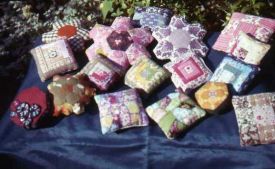Discovering the Barbara Bailey Artefact Collection
Published: Monday, 14th December 2009 12:58 PM

The Barbara Bailey Artefact Collection at the Quilt Museum and Gallery
Gardens and the diversity of plants they contain are a common feature in patchwork and quilting. Grandmother’s Garden is a popular pattern for beginners, where interlocking hexagons make up flower petals; cotton prints are often sprigged with floral delights; and the bounty of gardens – their richness and colour - often inspire us to gather fabric and design an heirloom quilt of our own.
Barbara Bailey, whose generous legacy to the Quilt Museum has resulted in the eponymously named side gallery leading off the Main Hall, was a passionate quilter and one whose garden was the driving force behind so many of her successful designs. A founder member of the Quilters' Guild in 1979, a member who never missed a meeting, Miss Bailey sadly died, and her collection was given to the museum in 1993. However, over the past few months, I have enjoyed archiving a collection of printed ephemera she donated to the museum as a bequest, alongside several of her quilts. It hasn’t mattered if the day has been cloudy or if rain has been puttering on the Museum roof; opening up the Bailey archive has meant an immediate immersion in green, like literally opening the curtains on a bright spring day, or staring into a riverside pool. Barbara did love gardens, and her fondness for leaves, foliage, bark, buds, trees and flowers of all kinds is indicated in the dozens of photographs and slides that she took of her garden at Garth, and the surrounding area.
Indeed, whilst thoughtfully linking these small apertures on her world with the lovingly constructed quilts that we now hold in the Museum collection, my role could be likened to that of gardener also: raking back weeds to reach fresh soil, allowing older flowers to see the light again and tending the densely planted earth that Miss Bailey has left us through her notebooks, images and quilts. I came to ask: How does the environment shape our sense of colour and spatiality? How can the landscape be transmitted in the form of a quilt? How has the work of the early founders of the Quilter’s Guild influenced us today? And indeed, for consideration here, who was Barbara Bailey?
Barbara Bailey’s career background was initially in nursing and she began patchwork so as to introduce it as a therapy on her orthopaedic ward. After several years in nursing, she turned to her other love, horticulture, first working in a plant nursery, then devoting herself to the creation of her magnificent garden at Garth. However, a back injury caused her to rethink her career choice, and as she was convalescing at home, she took an adult education sewing class in order to keep herself occupied. As Dianne Huck elaborates in the Spring 1989 edition of Patchwork and Quilting Magazine, it was a sewing class for making small things, but ‘being Barbara, she made a quilt in hexagons, as she had been shown’.
It appears that the turning point of Barbara Bailey’s life, or certainly the point at which her interests accelerated, came with the mingling of her natural, horticultural sensibilities with this rediscovery of cloth, and I would suggest, that throughout her life, this melding of nature with the production of quilts, was to become her hallmark: her eye for patchwork and her passion for supporting the growth of a quilting community in the UK simultaneously rooted in garden and home.
Certainly, it is difficult to prise her quilting attainments from the context of Garth – the rambling house she shared for many years with her sister, Dulcie and an assortment of animals including cats and a much loved and photographed Muscovy duck. As well as inspiring her work, it was the background for the successful quilt group she started, The Garth and Wraxhall Quilters, which met regularly there; an informal gathering of women of all ages, who produced an eclectic assortment of quilts, which were shown (to some success) at quilt fairs nationwide.
The garden at Garth is integral to the quilts Barbara produced and so the collection of photographs cataloguing each season there is a necessary part of the archive. Through these images we are shown a densely planted space with a strongly layered horizontal and wide array of textures. Grassy avenues are hedged with herbaceous borders and dark shadowy demarcations of fir invite you to step into different rooms, areas and spaces. Laburnums resplendent with yellow tassels swing in the breeze, with the spires and rosettes of Aqualegia, Yarrow, Daisies and Foxgloves giving the garden an intrinsic Englishness.
Such a dense planting scheme seems to fit with the prioritising of detail in Barbara Bailey’s quilts. Indeed, her particular predilection for the miniature is illustrated by her involvement in a book project instigated by Averil Colby on miniature quilts. Sadly, Miss Colby died before the project could come to fruition, but the quilts, alongside a small bed for displaying them, have been passed to us in York and form a core part of the Bailey bequest.
Quilts and gardens, textiles and the natural world combine in Barbara Bailey’s vision. As a volunteer in archiving this collection, I have witnessed how the making of quilts can be a holistic enterprise, feeding not just on thread and fabric but upon experiences and connections. Certainly, in Barbara Bailey’s oeuvre the gardener is not separate from the quilter, but rather, both run together, overlaid with an appreciation for colour, form and light and a deep and abiding sensitivity to place.
Dr Lee Ronald (museum volunteer)
June 2009
 Barbara Bailey's flower garden
Barbara Bailey's flower garden
 Quilted cushions
Quilted cushions
 Barbara's flowers
Barbara's flowers
 Garden path
Garden path